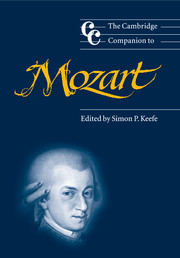Book contents
- Frontmatter
- Introduction
- Part I Mozart in context
- Part II The works
- 5 The keyboard music
- 6 The concertos in aesthetic and stylistic context
- 7 The orchestral music
- 8 Mozart's chamber music
- 9 Mozart as a vocal composer
- 10 The opere buffe
- 11 Mozart and opera seria
- 12 Mozart's German operas
- Part III Reception
- Part IV Performance
- Notes
- Selected further reading
- General index
- Index of Mozart’s works
8 - Mozart's chamber music
from Part II - The works
Published online by Cambridge University Press: 28 September 2011
- Frontmatter
- Introduction
- Part I Mozart in context
- Part II The works
- 5 The keyboard music
- 6 The concertos in aesthetic and stylistic context
- 7 The orchestral music
- 8 Mozart's chamber music
- 9 Mozart as a vocal composer
- 10 The opere buffe
- 11 Mozart and opera seria
- 12 Mozart's German operas
- Part III Reception
- Part IV Performance
- Notes
- Selected further reading
- General index
- Index of Mozart’s works
Summary
salieri: . . . the concert began. I heard it through the door – some serenade – at first only vaguely . . . but presently the sound insisted – a solemn Adagio in E flat. It started simply enough: just a pulse in the lowest registers – bassoons and basset horns – like a rusty squeezebox. It would have been comic except for the slowness, which gave it instead a sort of serenity. And then suddenly, high above it, sounded a single note on the oboe. It hung there unwavering, piercing me through, till breath could hold it no longer, and a clarinet withdrew it out of me, and sweetened it into a phrase of such delight it had me trembling. The light flickered in the room. My eyes clouded! The squeezebox groaned louder, and over it the higher instruments wailed and warbled, throwing lines of sound around me – long lines of pain around and through me. Ah, the pain! Pain as I had never known it. I called up my sharp old God, ‘What is this? . . . What?!’ But the squeezebox went on and on, and the pain cut deeper into my shaking head, until suddenly I was running, dashing through the side door, stumbling downstairs into the street, into the cold night, gasping for life.
Salieri's description of Mozart's Serenade for Winds in B flat major, K. 361 (example 8.1), does the work – as well as some commonly held beliefs concerning both Mozart and chamber music – surprising justice on a number of counts: it describes a sophisticated interplay of instruments (oboe and clarinet), an enveloping intimacy of expression (‘around and through me’) and a self-conscious manipulation of artifice and affect (‘it would have been comic except for the slowness, which gave it instead a sort of serenity’). But is the serenade, composed for thirteen wind instruments with double bass and performed publicly at the Burgtheater on 23 March 1784, a piece of chamber music?
- Type
- Chapter
- Information
- The Cambridge Companion to Mozart , pp. 105 - 117Publisher: Cambridge University PressPrint publication year: 2003
- 2
- Cited by



